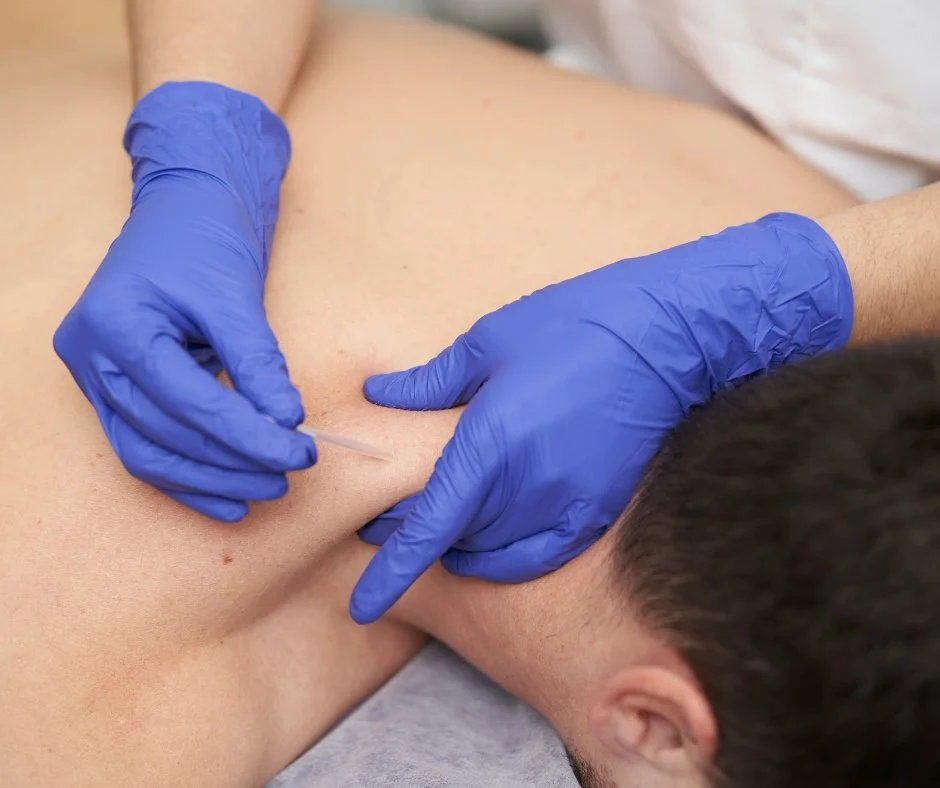Dry Needling Services in Potomac, MD
Your Solution for Pain Relief
Dry needling targets trigger points — localized, tight muscles that can form painful knots when overworked — and provides pain relief for injuries and chronic pain. Whether you’re in the recovery process, or experiencing chronic pain, schedule an assessment with us to find out how dry needling can help!
Who Can Benefit from Dry Needling?
Dry needling can be used to treat a range of conditions, including but not limited to:
Myofascial Pain Syndrome
Muscle strains and sprains
Chronic or acute back, neck, hip, leg, calf, or knee pain
Rotator cuff injuries and frozen shoulder (adhesive capsulitis)
Tension-type headaches and migraine-related muscle tension
Sciatica
Repetitive strain injuries
Dry needling may not be right for everyone, so we only offer these services as part of a larger care plan. Everyone must have an initial assessment done before starting any physical therapy plan. During your assessment, we will let you know if you’re a good fit for dry needling.
Benefits of Dry Needling
Dry needling targets both chronic and acute pain and has numerous benefits, including:
-

Reduced Inflammation
-

Enhanced Blood Flow
-

Release and Relaxes Tight Muscles
-

Reduced Muscle Spasms
-

Increased Range of Motion
-

Promote Local Tissue Healing
What Our Clients Say
“Stacy is the most amazing physical therapist! She's treated me for close to 10 years, and every injury I've had she's taken care of. Her knowledge, skill and experience are beyond amazing, and I have a lot of gratitude that we met all those years ago and she's in my life.”
— Stephanie
What is Dry Needling?
Trigger point dry needling is a therapeutic technique that treats painful muscle knots that result from injury or overuse. When included in your overall physical therapy treatment plan, dry needling can help relieve muscle tension, reduce pain, and increase your range of motion.
Is dry needling the same as acupuncture?
Nope! Dry needling and acupuncture are two very different procedures. Both use the same type of needle, but their applications and intentions are very different.
Dry needling focuses on anatomical trigger points to alleviate muscle pain and improve function.
Acupuncture, on the other hand, originates from Traditional Chinese Medicine and aims to balance the body's energy by stimulating points along meridians to address a broader range of conditions.
How dry needling works
During a dry needling session, your physical therapist will insert a thin needle into specific myofascial trigger points, depending on where you are experiencing pain or discomfort.
The needle is inserted to a precise depth to elicit a twitch response (a quick contraction of the muscle fibers). This response helps to break the cycle of muscle tightness and pain.
*Do needles make you feel uncomfortable?
Don’t worry! Each session only lasts a few minutes and is relatively painless. Needles are only used for 30 seconds or less. You’ll feel a slight pinching sensation, followed by pain relief in the targeted area almost instantly.
The Process
STEP 1:
Locate Trigger Point
STEP 2:
Insert Needle
STEP 3:
Piston Needle to Create a Twitch Response
STEP 4:
Remove Needle
Find Out if Dry Needling is Right for You
Our Expertise in Dry Needling
You’re in good hands! With over 20 years of experience, our physical therapist can help you find the right treatment plan. From former athletes to those passionate about the game, our team has specialized training to evaluate and treat orthopedic injuries, including dry needling.
We’ll help you find what works for you so you can get back on your feet and do more of what you love!
-

KinetaCore® certified Functional Dry Needling® Practitioner
-

Certified Integrated Manual Therapist (CIMT) from Great Lakes Seminars
-

Certified Strength and Conditioning Specialist (CSCS) through the National Strength and Conditioning Association
-

Sportsmetrics™ Certified Trainer for ACL prevention in female athletes
-

Pilates certified for rehabilitation through Polestar Pilates
-

Certified Functional Medicine Health Coach through FMCA/IFM
-

Health advisor to the Maryland State Youth Soccer Association
-

Best of Bethesda: Won in 2017 and was “top vote getter” 2019, 2020, 2023, 2024
-

Presented “Overuse Injuries in Soccer: Prevention, Identification and Recovery” at the NSCAA Annual Convention, Baltimore, MD, January 2016 (NSCAA = National Soccer Coaches Association of America)
Meet the Team
Dr. Stacy E. King
PT, DPT, OCS, CIMT, CSCS
Owner, Lead Physical Therapist, former athlete, and 2x hip replacement patient.
Learn more about Dr. Stacy E. King here!
Frequently Asked Questions
Have more questions?
-
Dry needling isn’t necessarily painful. Sometimes, patients experience “deeper” muscle activation or report feeling achy. However, you can expect to feel slight discomfort when the needle is inserted, or a twitch or cramping sensation in the muscle.
-
The number of sessions will depend on your treatment plan and duration. However, most clients can expect 1 session per week if indicated and usually not more than 8 sessions in the same area.
-
Side effects are mild and may include temporary soreness, bruising, or minor bleeding at the needle insertion sites.
-
Sessions usually last a few minutes but depends on the number of trigger points being treated and the complexity of the condition.
-
Yes, dry needling can be combined with other physical therapy treatments! Your physical therapist will cover how this can work in your treatment plan.
Book Your Dry Needling Session
Regardless of why, you want to find relief — we can help! Schedule an assessment and ask us about how to add dry needling to your physical therapy plan!



